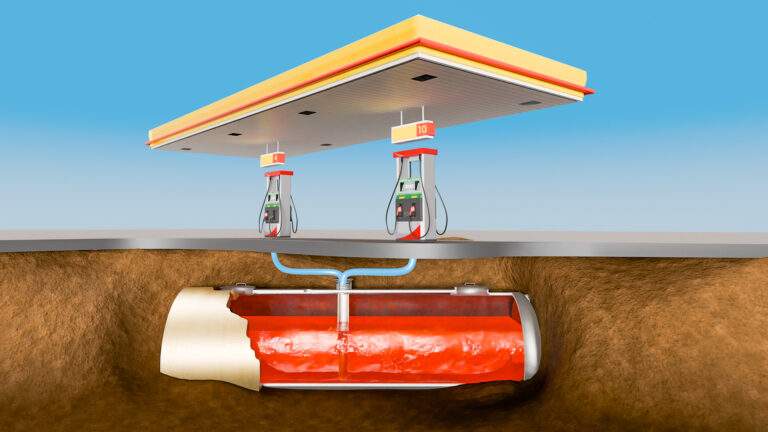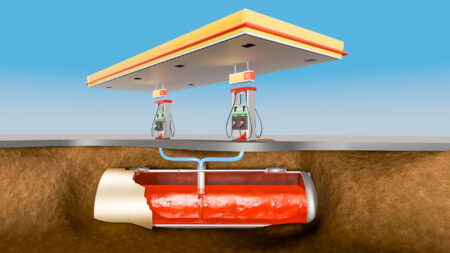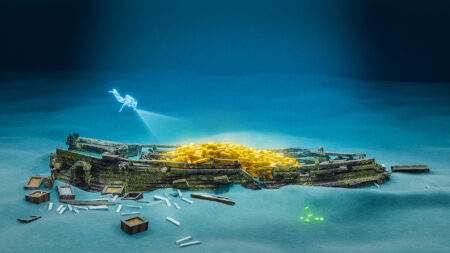As the Saturn V sat on the launch pad, moments away from lifting off and taking the Apollo 11 astronauts to the Moon, NASA commentator Jack King says this. Guidance is internal. It may not seem very significant, but it meant that the Saturn V was now relying on its own guidance system, the one that would steer it towards the Moon.
This incredible system was completely independent from the outside world, and worked by measuring how the rocket’s velocity and orientation had changed relative to its starting position. Because of this, the rocket needed to be absolutely sure of its starting position, or else it would end up on a completely different trajectory.
Say you have a car that’s programmed to follow this trajectory through a crossroads. Its guidance system only knows that it accelerated and took a right turn. If we change the starting position of the car, the guidance system will see the exact same thing, but the car will end up in the wrong place. And so in order to follow the correct trajectory, the guidance system needs to know exactly where it’s starting from.
The Saturn V had a predetermined starting position: with its Y axis facing north and south, the Z axis facing east and west and its X axis pointing directly up. But as the Earth rotated, these axes would no longer reflect the rocket’s true orientation. So how did NASA correct this in time for launch?
Saturn V Guidance Unit
The entire Saturn V rocket was controlled by the instrument unit, located at the top of the 3rd stage. It contained the inertial guidance platform, an advanced mechanical gyroscope that could measure the rocket’s orientation with incredible accuracy.

The basic principle of a gyroscope involves a disc mounted on a 3 axis gimbal. The disc is free to rotate in every direction, but once the disc starts to spin, its angular momentum keeps it perfectly stable, even if the gimbals are rotated. The Saturn V’s gyroscope worked on the same principle, but was much more advanced.
Instead of a single spinning disc, the guidance unit had a central platform, containing 3 spinning gyros placed 90 degrees apart from each other. If the rocket’s orientation changed, these gyros would sense a slight change in torque, which was turned into an electrical signal.
That signal was then sent to motors on each gimbal which would reproduce the change in torque but in the opposite direction, canceling out the rotation and keeping the platform completely stable.
On the opposite side of the gimbal, a device would measure how much the gimbals had rotated relative to the platform, telling the rocket exactly what direction it was pointing in. This, along with the acceleration data, would allow the flight computers to plot the rocket’s trajectory. But if the gyroscope wasn’t perfectly aligned to the rocket’s axes during launch, it would completely throw off the rocket’s trajectory.

In the hours leading up to the launch, the Saturn V’s gyroscope would be powered on and trying to keep itself stable. However, the Earth was constantly rotating, which meant the rocket’s orientation was also slowly changing.
Without any external input, the gyroscope would become so misaligned that the rocket would think it was pointing sideways. And so, in order to fix this, the gyroscope had to be constantly reset by an special piece of machinery on the ground.
In order to reset the Saturn V’s gyroscope to the desired axes, it used highly accurate reference points. The Y and Z axes were reset by two pendulums located inside the guidance unit. These were weighted iron rods that floated on a pocket of air. As the Earth rotated, gravity would pull the mass downwards, keeping the rod perfectly level. The gimbals could then rotate the stable platform to match this. But in order to reset the X axis, NASA came up with a much more impressive solution.
200 meters away from the base of the Saturn V was a bunker, built into the ramp of the launch pad. Inside, there was a device called a theodolite, which could emit a beam of light and control its direction with incredible accuracy.

During the launch countdown, a beam of infrared light was emitted from the theodolite and up to the rocket at precisely 25 degrees, where it would enter via a small window on the Saturn V’s instrument unit.
From there, the light would reach one of two Porro prisms mounted inside the guidance unit. When light enters a Porro prism, it’s reflected twice, causing it to leave the prism at the same angle it entered. One prism was fixed to the stable platform and the other was motorized.
The theodolite in the bunker would communicate with the rocket and slowly rotate the motorized prism. Once the prism was in the correct orientation, it would reflect the beam of light back to the theodolite where a set of mirrors would direct it onto a detector.
Each prism was coated with a special material that would only reflect a specific wavelength of infrared light. This allowed the detector to plot exactly where each prism was relative to where it should be. Since the light left the prism at the same angle it entered, the orientation could be determined by how offset the outgoing and returning beams were on the detector.
The theodolite system was so accurate that it could align the gimbal to within one thousandth of a degree. Once the motorized prism was correctly positioned, a device would measure how much it had rotated relative to the stable platform.
The motor on the inner gimbal would then rotate the stable platform by this exact amount. If everything was correct, the second prism would then line up perfectly and reflect the light back to the theodolite.

This system worked perfectly, but it relied on the Saturn V being completely still. That wasn’t always the case.
When a rocket sits on the launch pad, strong winds can cause it to sway back and forth. This kind of movement would completely throw off the accuracy of the theodolite. And so, in order to get a reference for how much the rocket was swaying, the theodolite would focus on a third prism mounted to the outside of the rocket.
This would shine the light back to the theodolite’s detector, which would see it moving back and forth as the rocket swayed. The target points for the other two prisms could use this as a reference point. This system could account for the top of the rocket swaying more than 30 centimeters in either direction.
All of these ingenious systems worked autonomously to reset the gyroscope until 15 seconds before launch. From there, the rocket was on its own, with the task of guiding it and 3 astronauts all the way from the launch pad to a translunar trajectory.













Thank you for your sharing. I am worried that I lack creative ideas. It is your article that makes me full of hope. Thank you. But, I have a question, can you help me?